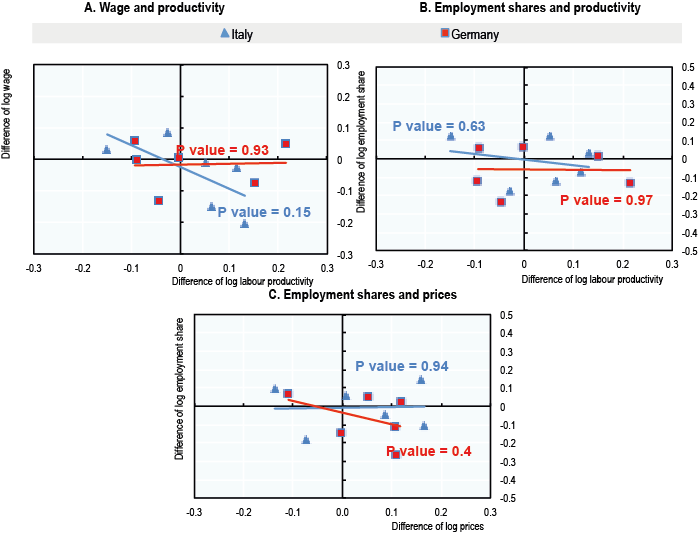Labour market reforms have been at the core of Italy’s political discourse for many years. Reforms, whether proposed or implemented, have concentrated primarily on job flexibility:
- The idea that hiring and firing costs should be reduced;
- That lay-offs should not result in costly and uncertain legal controversies (e.g. the debate around article 18 of the Labour Statute);
- That labour contracts should ensure flexibility without creating job insecurity;
- That workers’ rights and protections should be equalised, overcoming the duality between protected ‘insiders’ and flexible ‘outsiders’.
The recent reforms implemented by the Monti government have extended income protection schemes, such as unemployment benefits, while trying to improve job security. The Renzi government has recently introduced new measures aimed at removing hiring and firing costs, particularly for young workers.
The underlying assumption of such reforms is that workers who lose their job in unproductive firms and industries, and young people entering the labour market, should be able to move/find a job in expanding, more productive firms and sectors. Yet, the impact of past reforms on labour productivity is far from encouraging.
Aggregate data clearly show that Italy’s labour productivity has been stagnating for the past 13 years despite all reforms. Cumulatively, it has grown by just 2% – against 20% for Germany. It is hard to believe that without the implemented reforms the situation could have been worse.
In this column, we argue that by focusing merely on flexibility, past labour market reforms have completely neglected a crucial aspect: the one of incentives. In order for the most productive firms to be able to attract labour and capital, salaries must reflect productivity, otherwise flexibility may have perverse consequences on productivity growth.
Our analysis draws two main conclusions, which highlight a severe problem in the allocative role of the Italian labour market.
- Since 2000, Italian salaries have grown more in those sectors in which productivity has increased less.
- In the short term, employment has moved towards sectors where labour productivity increased less.
How an efficient labour market should work
Let us consider a simplified world with two sectors – 1 and 2 – in which firms produce two differentiated products – 1 and 2 – and use only one factor of production, labour, assumed to be homogeneous and fixed in supply. Firms are identical within each sector, but may differ between sectors.
In both sectors a firm’s demand for labour decreases with the real wage. In addition, we assume that workers look for a job in firms/sectors that offer the highest wage, but that moving from one sector to the other requires time due to the existence of search frictions, and due to the need to acquire new sector-specific skills.
Let us consider the effects of a technological innovation that raises labour productivity in sector 1. Firms operating in this sector will initially earn more profits and will want to expand production by increasing their labour force. Therefore, they will be willing to pay higher wages than those offered in sector 2. As a consequence, at first, salaries will increase in sector 1, attracting workers from sector 2. Because the supply of workers in sector 1 increases over time (whilst decreasing in sector 2), sector 1’s salary will then start to fall, whereas that of sector 2 will start to increase, until the wage difference evens out. At that point, the reallocation of labour between sectors will end.
It is important to note that the outcome would be the same in the case of a price increase of the goods produced in sector 1, relative to those in sector 2: profits in sector 1 will increase, and the same dynamics described above would follow. Therefore, the rise in a sector’s employment share may also reflect higher market power, favourable legislation hindering competition, or simply more demand for firms in that sector rather than higher productivity.
Stylised facts
Our analysis is based on Eurostat’s quarterly sector data compiled by Zsolt Darvas (2012 a,b). The sample spans from 2000 to 2013 and offers information on the number of employees, the hourly wage, the labour productivity (value added per hour worked), and the price of goods for six industries: finance, real estate, construction, services and manufacturing, for Italy and Germany.
We ask two questions:
- Do real wages reflect sectors’ productivity in the two countries?
- Do employment shares move together with the relative labour productivity of the different sectors?
Figure 1 summarises the relationship between wages, productivity, prices, and employment in different sectors in the two countries for the past 13 years. In the first quadrant on the left, each data point represents a sector, and its coordinates are the cumulative change of the relative productivity of the sector (on the x-axis) and the cumulative change in the relative wage of the sector (y-axis), between 2000 and 2013.1
Figure 1. Cumulative change in relative wages, productivity, prices, and employment by sector, Italy vs. Germany
Source: Authors’ calculations.
In Italy (in blue), the dots cluster around a downward sloping line: wages have increased relatively more in sectors where productivity has fallen in relative terms, while in Germany (in red), the sectors cluster around an upward sloping line. The top right quadrant shows the relationship between the cumulative change in a sector’s employment share and the cumulative change of its relative productivity. Once again, Italy’s dots cluster around a downward sloping line – employment shares have grown more for sectors whose productivity has fallen more in relative terms – the opposite of what has happened in Germany. Finally, the bottom quadrant shows the partial correlation between employment shares and the relative prices of goods. In Italy, but not in Germany, this correlation is positive – employment has grown more in sectors where prices have risen more.
Econometric analysis
The econometric analysis confirms the results shown in the graphs above.2 Table 1 reports the effects of an increase in the relative productivity on the relative wage in a sector, and on its employment share. The first column shows the impact effect (within the quarter), whereas the second column reports the cumulative effect in the long run.
Table 1. Effects of relative productivity on relative wage and employment share
Source: Authors’ calculations.
In the short run, in Italy a one percentage point rise in relative productivity in one sector has a small effect on the relative wage in that sector; this impact is half of the effect estimated for Germany.
In the long run, a 1% rise in a sector’s relative productivity in Italy is associated with a fall in the relative wage of almost 0.4 percentage points (first line, second column); whereas this effect is not statistically significant in Germany (this is consistent with our simple story, where wages in both sectors tend to converge in the long run).
Furthermore, in the short run, Italian employment shares tend to contract almost 1:1 when the relative sectorial productivity rises (see the coefficient -0.955 in the table). This ‘labour misallocation’ effect, though present in Germany, is four times stronger in Italy. The long run effects of productivity on labour shares are not significant in either country.
When we look at effects of relative prices, Germany and Italy once again display very different results (see Table 2). In Italy, a 1% rise in the relative price of the good produced in the sector results in a rise of almost 7/10 of a point of the sector’s relative wage, although this effect is reversed in the long run. Germany, by contrast, does not display such ‘real wage rigidity’ in the short run, as this effect turns out to be negligible and statistically not significant. In the long run, relative prices do not have significant effects on employment shares in either country.
Table 2. Effects of relative price on relative wage and employment share
Source: Authors’ calculations.
Discussion and conclusions
Our analysis suggests that in Italy, in contrast with Germany, wages do not substantially reflect sector productivity in the short run, while in the long-run, they tend to rise in sectors in which productivity falls. Moreover, in the short-run relative wages in Italy respond much more to changes in relative prices than in Germany. Finally, employment in Italy tends to move towards less productive sectors. This ‘allocation failure’ of the labour market calls into question the current model of wage bargaining.
What are the critical aspects? In Italy, the share of contracts covered by some form of collective bargaining is among the highest among Western countries: around 85%. This happens despite the fact that union membership is on the low side, around 30%, in international comparison. The reason is that collective contracts typically apply to non-unionised workers as well as unionised ones, and they are also enforced outside the sector where they are negotiated. Furthermore, while the average length of collective contracts in Italy is 3 years, in line with the OECD average, the de-facto duration is much longer, due to recurring delays in contracts’ renewals.3 As of today, only between 30 to 40% of Italian firms use in-company bargaining (Treu 2009), while this percentage is close to zero for companies located in the South.
Germany’s institutional framework is very different. Collective bargaining takes place at Lander level; this helps keeping wages well in line with firms’ productivity in a situation where there is a lot of heterogeneity among regions. This ‘opt-out’ clause has recently been introduced in Spain and has allowed wages to align to productivity at the firm level.
In the list of priorities for labour market reforms, we think that the goal of re-establishing a strong relationship between wages and productivity at the firm (and employee) level should come first. This requires shifting the main level of wage determination to the firm level. Otherwise, introducing additional elements of flexibility in a distorted labour market would have little or perverse effects on labour productivity, wages, and employment.
Footnotes
1. The graph displays partial correlations between relative wages and relative productivities, which filter out the effects of relative process and sector specific fixed effects. Variables are in logarithmic scale.
2. We estimate a simple econometric model that allows us to evaluate how much wages and employment respond to productivity and relative prices, both in the short (quarter) and in the long-term (steady state). We use an ‘error correction’ approach (Davidson et al. 1978).
3. In 2011, a proposal to change collective bargaining in order to adapt it to different companies’ size was implemented (Riforma Sacconi) but was unsuccessful. The reform authorised social partners to waive the national collective contract on many issues. However, this option was limited to “the most representative labour unions”. As these were never defined, the reform could not be fully implemented.
References
Cella, G P and T Treu (2009), Relazioni industriali e contrattazione collettiva, Bologna: Il Mulino.
Darvas, Zsolt (2012a), “Compositional effects on productivity, labour cost and export adjustments”, Bruegel Working Paper.
Darvas, Zsolt (2012b), “Productivity, labour cost and export adjustment: Detailed results for 24 EU countries”, Bruegel Working Paper.
Davidson, J E H, D F Hendry, F Srba, J S Yeo (1978), “Econometric modelling of the aggregate time-series relationship between consumers’ expenditure and income in the United Kingdom”, Economic Journal, 88(352): 661–692.
De Caju, P, E Gautier, D Momferatou and M Ward-Warmedinger (2008), “Institutional Features of Wage Bargaining in 23 European Countries, the US and Japan”, ECB Working Paper 974.
OECD (2014), “The 2012 Labour market reform in Spain: A preliminary assessment”.
Visser, J (2013), “ICTWSS Database on Institutions, Coordination, Trade Unions, Wage Setting and Social Pacts” (version 4, April), Amsterdam Institute for Advanced Labour Studies.





